
Svinišće is a village in the split-dalmatia region.
It is located at the foot of Omis dinara mountain, on the north side.
1315 year is mentioned in the charter, which the Croatian prince Juraj Subic from Klis city admits to citizens of Brela, Rogoznica, Svinisce and Kucice of the same privileges as other members of the commune of Omis.
PROUD HISTORY OMIŠ
Not many towns in the world count their history in thousands of years, but the town of Omiš is one of them!
The mouth of the Cetina river was first permanently inhabited in ancient times, more than 2000 years ago, and historians believe that the origins of the present-day Omiš are to be found in the small settlement of Oneum, which lay at the very foot of the impressive mountain guarding the town from the north – Omiška DInara.
Over the centuries the local people started building their houses closer to the sea, and for a very good reason. The inhabitants of medieval Omiš were, as a matter of fact, pirates!
Throughout the entire 12th and 13th centuries the pirates of Omiš ruled the seas from Omiš to Dubrovnik, and all ships sailing by this small town at the Cetina mouth were forced to pay tribute for free passage or risked enaging in a battle against the ruthless pirates of Omiš in which only few came out the winners.
Lead by the famous dukes of the Kačić family, the pirates of Omiš thus ruled a large part of the Adriatic for almost two centuries, attacking large merchant ships of rich cities such as Split, Kotor, Dubrovnik and Venice, and even papal galleons sailing across the Adriatic on their way to the far Palestine.
As time went by, the pirates of Omiš grew so powerful that in 1221 Pope Honorius III organized a crusade against them , in which his army was defeated. However, no more than 60 years later, the Venetians, again under the Pope’s order, launched yet another crusade against the infamous pirates from the Cetina river, this time with somewhat more success.
It was one of the few, but at the same time a crushing defeat of the Omiš pirates in naval battles. Not long after having been defeated by the Venetians, the dukes of the Kačić family fled the town, and their power became significantly diminished. Although they continued practicing piracy, the inhabitants of Omiš increasingly started looking for alternative sources of income in agriculture and fishing.
In the 15th Omiš officially came under Venetian rule and the town itself developed into an important administrative and military stronghold and was surrounded by high walls.
It was precisely during the Venetian rule that Omiš acquired its present appearance and architectural form. Since the town developed within the boundaries of its high fortifications, the architects had limited space for wide alleys and grand houses. The alleys of the old town were therefore quite narrow, and intersected only by numerous squares and piazzas which were the venues of public life in the early Modern Period.
However, the town gradually grew too big and overpopulated to remain confined within its large walls. Not long after the fall of the Venetian Republic , at the beginning of the 19th century, the town planners decided to pull down the medieval town walls, and the Eastern town gate, along with the Turjun tower overlooking the main street of Fošal, remained as the sole reminders of the great old “giant” that guarded Omiš from invaders throughout centuries.
After the fall of the Republic of Venice, at the beginning of the 19th cet Omiš came under the rule of Austria, and in 1807 along with the rest of Dalmatia became part of Napoleon’s France , only to again be returned to Austria in 1813, under the rule of which it remained until the beginning of World War I in 1918.
In the following period Omiš, along with most of Croatia, went through two Yugoslav states, and in 1991 finally concluded it turbulent history by becoming part of the independent and autonomous Republic of Croatia.
The Riviera
South of the very town of Omiš, along almost 20 km of the coast, stretches the Riviera of Omiš, with its numerous small villages and fishermen’s ports, offering escape from the hustle and bustle of city life. Although geographically not far apart, each of the villages has its own story to tell, and each offers visitors something new and unique. Along the Riviera you’ll find dozens of grocery stores, restaurants, hotels and hundreds of private vacation rentals where you can put your feet up and relax on your sea-view balcony, which almost every house on the Riviera of Omiš boasts.
Nemira
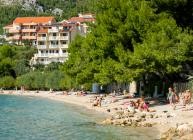 Closest to Omiš lies Nemira, a quiet coastal village situated in a bay, where you’ll be able to spend your vacation in peace and quiet, enjoying the clear sea in the shade of pine trees, away from the busy streets and crowds of town.
Closest to Omiš lies Nemira, a quiet coastal village situated in a bay, where you’ll be able to spend your vacation in peace and quiet, enjoying the clear sea in the shade of pine trees, away from the busy streets and crowds of town.
Stanići
The village of Stanići is an old fishermen’s settlement, known for its long pebble beaches and the famous cove of Velika Luka, where you’ll experience one of the most beautiful sunsets on the Adriatic.
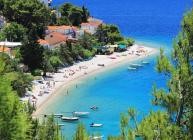
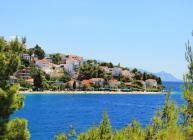
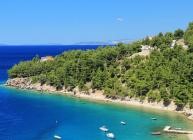
Čelina
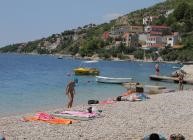 Right next to Stanići, you’ll find the village of Čelina –a typical Dalmatian coastal village, where people have for centuries lived from the sea and with the sea. The present-day Čelina is situated by the Adriatic Highway, and if you do decide to choose it as your holiday destination, be sure to leave an afternoon free to visit the 800 years old medieval village of Čelina, situated on the mountain above the today’s tourist resort.
Right next to Stanići, you’ll find the village of Čelina –a typical Dalmatian coastal village, where people have for centuries lived from the sea and with the sea. The present-day Čelina is situated by the Adriatic Highway, and if you do decide to choose it as your holiday destination, be sure to leave an afternoon free to visit the 800 years old medieval village of Čelina, situated on the mountain above the today’s tourist resort.
Lokva Rogoznica
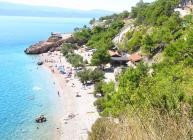 The more than 700 years old village of Lokva Rogoznica was, as legend has it, founded by 7 noble families which were given the land by King Bela IV , and used it for farming, agriculture, fishing and especially winemaking. In the old days, the inhabitants of Rogoznica were mostly land workers and their homes were situated high up on the slopes of the Dinara mountain. Many of the paths that the inhabitants of old Lokva Rogoznica used in order to reach the invaluable sources of fresh water on the coast are still in use today.
The more than 700 years old village of Lokva Rogoznica was, as legend has it, founded by 7 noble families which were given the land by King Bela IV , and used it for farming, agriculture, fishing and especially winemaking. In the old days, the inhabitants of Rogoznica were mostly land workers and their homes were situated high up on the slopes of the Dinara mountain. Many of the paths that the inhabitants of old Lokva Rogoznica used in order to reach the invaluable sources of fresh water on the coast are still in use today.
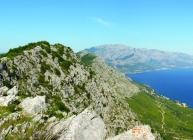 After the construction of the Adriatic Highway, the villagers started building their houses below it, closer to the sea, and Lokva started to develop into the famous tourist destination it is today and attracting numerous visitors with its beaches ideal for relaxation, its untouched nature and a bit of history you can experience when visiting the old village of Lokva and its numerous old chapels, some built more than 500 years ago! Especially interesting is the Church of Holy Vid, situated at the very peak of Omiška Dinara (at 639m above sea level) , which can be reached by a well-maintained walking trail, ideal for an afternoon or early-morning walking tour. Another interesting fact about Lokva Rogoznica is that, up until the 2nd half of the 20th century, many of its inhabitants lived from excavation of sand from the sea bottom – so called salbunjerstvo – a special traditional technique of sand digging which is extinct today. Also, according to some sources, it was precisely at the territory of Lokva that the medieval Code of Rogoznica (13th century) was written, as one of the oldest legal documents of the region.
After the construction of the Adriatic Highway, the villagers started building their houses below it, closer to the sea, and Lokva started to develop into the famous tourist destination it is today and attracting numerous visitors with its beaches ideal for relaxation, its untouched nature and a bit of history you can experience when visiting the old village of Lokva and its numerous old chapels, some built more than 500 years ago! Especially interesting is the Church of Holy Vid, situated at the very peak of Omiška Dinara (at 639m above sea level) , which can be reached by a well-maintained walking trail, ideal for an afternoon or early-morning walking tour. Another interesting fact about Lokva Rogoznica is that, up until the 2nd half of the 20th century, many of its inhabitants lived from excavation of sand from the sea bottom – so called salbunjerstvo – a special traditional technique of sand digging which is extinct today. Also, according to some sources, it was precisely at the territory of Lokva that the medieval Code of Rogoznica (13th century) was written, as one of the oldest legal documents of the region.
Medići i Mimice
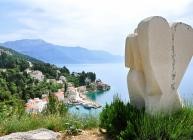 No more than 10 kilometers from Omiš and 25 kilometers from Makarska lie the villages of Medići and Mimice, two typically Mediterranean places which complement one another perfectly. In Medići you will find peace and one of the most beautiful beaches of the Omiš Riviera. The fine gravel and – due to favourable currents – always perfectly clear sea are what keeps a growing number of visitors returning to Medići each summer. And once you’ve had enough of the somewhat Robinson Crusoe-style vacation in Medići, an easy ten minutes’ walk away you’ll find Mimice – the prefect holiday getaway known for its many restaurants and taverns, grocery stores and local fishermen who will be glad to supply you with the freshest and most delicious fish at very affordable prices. Monuments by the Church in the old part of the village stand as witnesses of the more than three-hundred-year long history of Mimice and the spirit of the past can be felt at every step through its narrow alleyways lined with old stone houses. In recent years the old village of Mimice has been revived by the already widely known “art colony” – a well organized painting and sculpture workshop where, inspired by the amazing scenery of Mimice, you are bound to boost your creative flare.
No more than 10 kilometers from Omiš and 25 kilometers from Makarska lie the villages of Medići and Mimice, two typically Mediterranean places which complement one another perfectly. In Medići you will find peace and one of the most beautiful beaches of the Omiš Riviera. The fine gravel and – due to favourable currents – always perfectly clear sea are what keeps a growing number of visitors returning to Medići each summer. And once you’ve had enough of the somewhat Robinson Crusoe-style vacation in Medići, an easy ten minutes’ walk away you’ll find Mimice – the prefect holiday getaway known for its many restaurants and taverns, grocery stores and local fishermen who will be glad to supply you with the freshest and most delicious fish at very affordable prices. Monuments by the Church in the old part of the village stand as witnesses of the more than three-hundred-year long history of Mimice and the spirit of the past can be felt at every step through its narrow alleyways lined with old stone houses. In recent years the old village of Mimice has been revived by the already widely known “art colony” – a well organized painting and sculpture workshop where, inspired by the amazing scenery of Mimice, you are bound to boost your creative flare.
Marušići
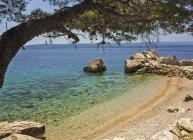
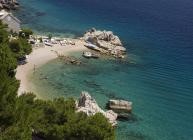
Although relatively small, Marušići are a village of numerous beaches and hidden coves – from those interesting pebble and gravel beaches ideal for families with children, to secluded ones, perfect for couples bound to enjoy the intimacy provided by the lush Mediterranean vegetation.
Pisak
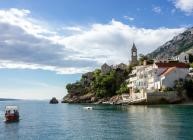 The farthest point of the Riviera of Omiš is Pisak – a true oasis of peace and, according to many, one of the most beautiful places of the Riviera. The inhabitants of Pisak are renown fishermen and the area is also famous for the production of premium quality wine and olive oil. Although relatively small, the village of Pisak offers its visitors both sandy and pebble beaches and it is widely known for the nearby famous cove of Vruja – one of the best locations for diving and spearfishing on the Adriatic.
The farthest point of the Riviera of Omiš is Pisak – a true oasis of peace and, according to many, one of the most beautiful places of the Riviera. The inhabitants of Pisak are renown fishermen and the area is also famous for the production of premium quality wine and olive oil. Although relatively small, the village of Pisak offers its visitors both sandy and pebble beaches and it is widely known for the nearby famous cove of Vruja – one of the best locations for diving and spearfishing on the Adriatic.
Poljica
 The first things that pop into your mind when imagining your vacation in Omiš are probably the sun, the sea and beautiful beaches. However, the municipal district of Omiš also includes the territory of Poljica – a group of villages situated along the foot of the Mosor mountain, boasting quite a rich and interesting history.
The first things that pop into your mind when imagining your vacation in Omiš are probably the sun, the sea and beautiful beaches. However, the municipal district of Omiš also includes the territory of Poljica – a group of villages situated along the foot of the Mosor mountain, boasting quite a rich and interesting history.
Situated away from the sea, on the other side of the Dinara mountain, Poljica are a rural area that offers escape from the hustle and bustle of the crowded town streets and beaches. But although an oasis of peace today, throughout the history the villages of Poljica were a venue of many significant battles.
From the 13th century onwards, the territory of the today’s Poljica was organized as the so called Republic of Poljica, which has remained a unique phenomenon in Europe due to its at the time quite progressive administrative form and social structure. The medieval Republic of Poljica was, in fact, governed by the people, who elected their leader – the great Prince of Poljica – through a democratic voting process held each year on St. George’s Day.
One of the basic legal acts governing the functioning of the Republic of Poljica was the famous Poljica Statute, originally written in the 14th century. This invaluable piece of Croatian legal history regulated in detail all aspects of economic and social life in the Republic of Poljica. Furthermore, the document is also a testament of how much ahead of their time the inhabitants of Poljica were, living, as they did, in one of the few truly democratic societies of the period. The Republic of Poljica was such a well-organised social system that some scientists today believe it was precisely the visit to this small community that inspired the writing of Thomas More’s indicatively titled masterpiece – “Utopia”.
The more than 600 years old Republic was finally abolished in 1807, following Napoleon’s conquest of Dalmatia, but numerous churches, houses and other monuments stand as silent witnesses of its rich history until today (such as the Early Christian Church in Podgrađe (5th century), the Nativity of the Blessed Virgin Mary Church and cemetery in Tugare(13th century), the 13th Roman Villa Rustica (5th century), as well as the famous Poljica Statute and “soparnik” – a delicious traditional dish from Poljica, today included on the official list of Croatian Intangible Cultural Heritage).
In addition to soparnik and the famous Poljica Statute, the most popular tourist attractions on the territory of Poljica are:
– The Church and Museum of Poljica from the 6th century in the village of Gata – the old Early Christian Church bears testimony of the rich life of Poljica ever since ancient times, and the Museum of Poljica boasts a valuable historical collection from which you can learn a thing or two about the culture and everyday life of the old inhabitants of Poljica.
– The Pavić Bridge (“Pavića most”) – one of the oldest bridges over the Cetina river was built in year 1900, but despite time having taken its toll on it and the damage done to it by explosives during World War II, remains in use until today. After extensive reconstruction works in 2012 it was finally renewed and reinforced and is today even passable by car.
– Gradac/The Church of St. George – built the high up on the hill of Gradac (at 353 meters above sea level), the Church of St. George is one of the most beautiful and most visited churches on the entire territory of Poljica.
The Cetina Canyon
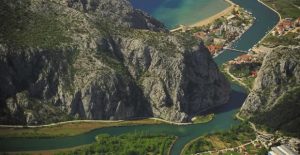 The greatest opportunities for an active holiday are provided precisely by the unspoiled nature of the Cetina canyon, which has enjoyed the status of protected significant landscape ever since 1963.
The greatest opportunities for an active holiday are provided precisely by the unspoiled nature of the Cetina canyon, which has enjoyed the status of protected significant landscape ever since 1963.
Along its more than a 100 kilometers long course, the Cetina river has something to offer to all. If you’re an adrenaline junkie, you won’t skip Zipline, canyoning, kayaking or rafting – but if, on the other hand, adrenaline isn’t your thing, there’s no reason to worry – long walks by the river, sightseeing river boat tours or pure, spontaneous enjoyment of the scenery will definitely be a reward in themselves.
As reminders of the turbulent history of the region, numerous medieval forts can still be found along the entire course of the Cetina. Some of them are well hidden and partly destroyed, whereas others still proudly stand high above the Cetina, serving as vantage points over the amazing canyon. The most famous among them is the fort of Viseć, located not far from the popular excursion and picnic place of Radmanove mlinice (Radman Mills) – another well hidden jewel amidst the unspoiled nature of the Cetina canyon.
The power of the Cetina river had been used to spin the wooden water wheel of the local mills ever since the 16th century, and in the 19th century the complex of the mills was taken over by the Radman family, who gradually started using it as a summer villa.
The old mill in Radmanovemlinice still stands, but only as an attraction for numerous tourists visiting this beautiful excursion place, which is today one of the most popular of its kind in this part of Dalmatia. It is interesting to note that, due to the one of a kind scenery and unspoiled nature, Radmanove Mlinice were chosen as one of the locations for the filming of the famous Winnetou movie in the period from 1962 to 1969.
Active holiday
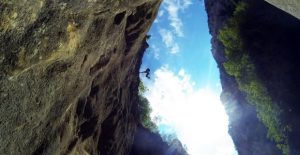 If your perfect vacation includes a dose of adrenaline, then Omiš is definitely the right choice for you. There is hardly a sea, water, mountain or air activity not offered in the greater Omiš area. There are truly not many other towns or cities in the world where you can start off the morning riding the river rapids, find yourself a hundered meters up in the air, hanging from a wire in the middle of the Cetina canyon around noon, be climbing the nearby mountain top accombanied by professional climbing instructors in the afternoon and then fly a paraglider down to the beautiful sandy beach where you can still manage to take a swim before sunset. When spending your vacation in Omiš, the only question is how many different activities your body can take in a day!
If your perfect vacation includes a dose of adrenaline, then Omiš is definitely the right choice for you. There is hardly a sea, water, mountain or air activity not offered in the greater Omiš area. There are truly not many other towns or cities in the world where you can start off the morning riding the river rapids, find yourself a hundered meters up in the air, hanging from a wire in the middle of the Cetina canyon around noon, be climbing the nearby mountain top accombanied by professional climbing instructors in the afternoon and then fly a paraglider down to the beautiful sandy beach where you can still manage to take a swim before sunset. When spending your vacation in Omiš, the only question is how many different activities your body can take in a day!
But, no worries, you don’t have to be in perfect shape in order to enjoy the wide range of outdoor activities available in Omiš. Most of them are appropriate for all ages, and below you can find just a small portion of the wide offer of adrenaline experiences you can choose from once in Omiš.
Zipline
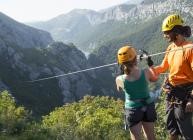 Zipline is one of the latest additions to the town’s tourist offer and, according to many, one of the most spectacular. During the three-hour Zipline adventure you’ll experience the amazing canyon of the Cetina river in a really unique way.
Zipline is one of the latest additions to the town’s tourist offer and, according to many, one of the most spectacular. During the three-hour Zipline adventure you’ll experience the amazing canyon of the Cetina river in a really unique way. 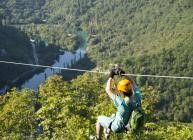 How unique, you might wonder. Well, more than three hours of crazy high-speed sliding down 2 km long wires, some of which running at more than 100 meters above ground, that unique.
How unique, you might wonder. Well, more than three hours of crazy high-speed sliding down 2 km long wires, some of which running at more than 100 meters above ground, that unique.
You’ll definitely be telling your friends all about your Zipline adventure long after returning from holiday, and for the maximum amount of jealousy be sure to take a second or two during the crazy rush across the Cetina canyon for a photo.
Theme trails
One of the perks of a vacation in Omiš are surely the long theme trails which, thanks to the efforts of local enthusiasts, are growing in number each year. There are several dozen trails in the area today that will take you – wherever you like! Following the well-marked trails leading from the very centre of Omiš in just a few hours you can reach the tops of the surrounding mountains, old pirate fortresses, amazing vantage points and numerous quaint villages of the region. Whatever direction you decide to take, you’ll find a trail that will lead you through untouched nature to a hidden, secluded place, not to be found on tourist maps. Omiš is in fact a place of countless surprises – the question is only whether you are bold enough to discover them all…
Hiking and Trekking
The town of Omiš lies in the embrace of three steep mountains – Omiška Dinara, Komorjak and Mosor. For centuries these mountains served as natural protection from enemies, whereas today they represent a perfect venue for hiking tours. Except for offering a number of well-marked theme trails suitable for recreational hikers and all-year-round tours, each spring the mountains around Omiš become the venue of the Spring Trekking Cup – a series of hiking/trekking marathons which, apart from endurance, also test one’s resourcefulness and orientation skills.
The Spring Trekking Cup today consists of three competitions – Imbertrek, Jesenice Trekking Cup and one of the oldest trekking races in Croatia – Mosor Grebbening.
Each year the Cup attracts hundreds of professional athletes to Omiš and the area, but also hordes of recreational runners , competing at somewhat shorter and easier courses. The Spring Trekking Cup is an adventure-run that celebrates nature and promotes a healthy life-style, and in spite of it formally being a race, most competitors put less value into the time it takes them to finish the race than into the time actually spent on the mountain with their families and friends – because this is what trekking really is about.
Great and Small Gubavica waterfalls
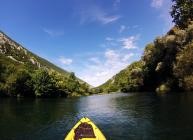 For tens of thousands of years the Cetina river shaped and formed the landscape along its course – it carried rocks, cut through mountains and slowly worked its way to the sea. During its millenary journey it created one of the most beautiful canyons in Croatia, a place hiding a new surprise at every corner. Two of the most amazing ones are perhaps the two waterfalls near the village of Zadvarje – the Great (Velika) (49 m) and Small (Mala) (7m) Gubavica, special among hundreds of others in the world for the fact that you can actually swim under them.
For tens of thousands of years the Cetina river shaped and formed the landscape along its course – it carried rocks, cut through mountains and slowly worked its way to the sea. During its millenary journey it created one of the most beautiful canyons in Croatia, a place hiding a new surprise at every corner. Two of the most amazing ones are perhaps the two waterfalls near the village of Zadvarje – the Great (Velika) (49 m) and Small (Mala) (7m) Gubavica, special among hundreds of others in the world for the fact that you can actually swim under them.
The location represents a breathtaking natural oasis in which the Cetina river, just meters away from the two mighty waterfalls, for a moment calms down and forms a nice swimming pond with a spectacular view of the roaring water masses dropping down from almost 50 m above you!
Rafting
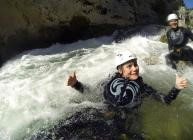 Rafting on the Cetina river has for over two decades been the favourite activity of many tourists spending at least a day in Omiš. What makes this river adventure especially attractive is the fact that it can be adapted to all. Families with kids and seniors will get to enjoy easy paddling through untouched nature, whereas adrenaline lovers will take a different route and measure their strength with a series of wild river rapids. Rafting on the Cetina river is an idyllic and peaceful nature trip which will, at your wish, turn into a first-rate adrenaline adventure in a blink of an eye. The choice is just yours to make!
Rafting on the Cetina river has for over two decades been the favourite activity of many tourists spending at least a day in Omiš. What makes this river adventure especially attractive is the fact that it can be adapted to all. Families with kids and seniors will get to enjoy easy paddling through untouched nature, whereas adrenaline lovers will take a different route and measure their strength with a series of wild river rapids. Rafting on the Cetina river is an idyllic and peaceful nature trip which will, at your wish, turn into a first-rate adrenaline adventure in a blink of an eye. The choice is just yours to make!
Kayaking
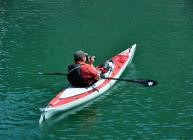 For those who’d prefer to be in full control while exploring the Cetina canyon, kayaking is the right choice. Much like with rafting, the level of adrenaline you’ll get to experience will largely depend on the chosen route. Small one- or two-person kayaks will enable you to closely explore even the most hidden and secluded parts of the canyon. Once in a kayak with a paddle in hand, the possibilities are practically endless – the only question is which route you are going to take?
For those who’d prefer to be in full control while exploring the Cetina canyon, kayaking is the right choice. Much like with rafting, the level of adrenaline you’ll get to experience will largely depend on the chosen route. Small one- or two-person kayaks will enable you to closely explore even the most hidden and secluded parts of the canyon. Once in a kayak with a paddle in hand, the possibilities are practically endless – the only question is which route you are going to take?
Canyoning
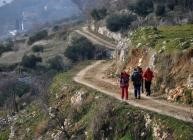 Rafting, kayaking and Zipline are definetly adventures you are not bound to forget any time soon. But if you really want to experience the Cetina river in its full splendor, there’s no better choice than Canyoning – an adrenaline adventure combining hiking along (and through!) the Cetina with swimming under waterfalls and mastering river rapids. Canyoning will give you a chance to truly “feel” the river, both literally and figuratively. But beware, this is an adventure no one gets out of dry 😉
Rafting, kayaking and Zipline are definetly adventures you are not bound to forget any time soon. But if you really want to experience the Cetina river in its full splendor, there’s no better choice than Canyoning – an adrenaline adventure combining hiking along (and through!) the Cetina with swimming under waterfalls and mastering river rapids. Canyoning will give you a chance to truly “feel” the river, both literally and figuratively. But beware, this is an adventure no one gets out of dry 😉
Ronjenje
 Omiš and the rest of its Riviera boast some of the most amazing beaches and coves in Dalmatia, and the possibilities it offers for scuba diving and exploring the underwater world are among the best on the Adriatic. Omiš simply has it all – from shallow underwater plains accessible to all, to deep and hidden walls and cliffs to be explored only by the most experienced divers. Oh, yes, we forgot to mention one thing. At the depth of only 3 meters not far from the central town beach you can find a sunken wreck of a World War II ship. And you know what they say – where there’s a shipwreck, hidden treasure can’t be that far either…
Omiš and the rest of its Riviera boast some of the most amazing beaches and coves in Dalmatia, and the possibilities it offers for scuba diving and exploring the underwater world are among the best on the Adriatic. Omiš simply has it all – from shallow underwater plains accessible to all, to deep and hidden walls and cliffs to be explored only by the most experienced divers. Oh, yes, we forgot to mention one thing. At the depth of only 3 meters not far from the central town beach you can find a sunken wreck of a World War II ship. And you know what they say – where there’s a shipwreck, hidden treasure can’t be that far either…
More experienced divers will no doubt be amazed by the cove of Vruja, which represents one of the best scuba diving sites in Croatia. This is a location of a large freshwater source and is, due to the mixing of fresh and sea water, exceptionally rich in fish and as such one of the most popular dive-in locations in Croatia among spear fishermen.
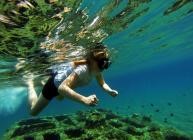 At the location of Vruja dives are possible to the depth of over 100 meters, whereas the sea bottom is almost completely unexplored since none of the many diving expeditions were able to determine the exact depth of the freshwater source of Vruja, after which the entire cove was named. But beware – this is not to be taken as a challenge! Diving at such depths is an extremely dangerous sport and recreational dives of this type are allowed only under expert guidance. If you are, nevertheless, bold enough and do find yourself in the blue depths of the Vruja cove, keep your eyes wide open. According to a local legend, at the very bottom of the Vruja, right next to the great freshwater source, you’ll find an ancient sunken city full of treasures and secrets just waiting to be discovered.
At the location of Vruja dives are possible to the depth of over 100 meters, whereas the sea bottom is almost completely unexplored since none of the many diving expeditions were able to determine the exact depth of the freshwater source of Vruja, after which the entire cove was named. But beware – this is not to be taken as a challenge! Diving at such depths is an extremely dangerous sport and recreational dives of this type are allowed only under expert guidance. If you are, nevertheless, bold enough and do find yourself in the blue depths of the Vruja cove, keep your eyes wide open. According to a local legend, at the very bottom of the Vruja, right next to the great freshwater source, you’ll find an ancient sunken city full of treasures and secrets just waiting to be discovered.
Free climbing
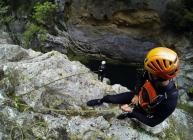 The view from high up on the Mirabela or Fortica fortress is surely something you will remember for a long time, but nothing beats a view you fought your way to with your bare hands. Omiš is, among other things, also widely known as one of the top two free climbing locations in Croatia, and adrenaline lovers are especially drawn to it by the fact that all climbing routes are just a couple of minutes away fom the town centre. Regardless if you are just a beginner or already an experienced free climber, in Omiš you will definitely find the right climbing route for you. Here you can take your first climbing steps, or you can truly push yourself to your limits. Whatever you do, there is always the big reward waiting for you at the top – a breathtaking view of the red roofs of the old town, the numerous islands of Dalmatia or the amazing Cetina canyon. And, finally, something important to note: required climbing equipment hereabouts includes a camera! Because wherever you turn once at the top, you’ll get a view worth capturing.
The view from high up on the Mirabela or Fortica fortress is surely something you will remember for a long time, but nothing beats a view you fought your way to with your bare hands. Omiš is, among other things, also widely known as one of the top two free climbing locations in Croatia, and adrenaline lovers are especially drawn to it by the fact that all climbing routes are just a couple of minutes away fom the town centre. Regardless if you are just a beginner or already an experienced free climber, in Omiš you will definitely find the right climbing route for you. Here you can take your first climbing steps, or you can truly push yourself to your limits. Whatever you do, there is always the big reward waiting for you at the top – a breathtaking view of the red roofs of the old town, the numerous islands of Dalmatia or the amazing Cetina canyon. And, finally, something important to note: required climbing equipment hereabouts includes a camera! Because wherever you turn once at the top, you’ll get a view worth capturing.

